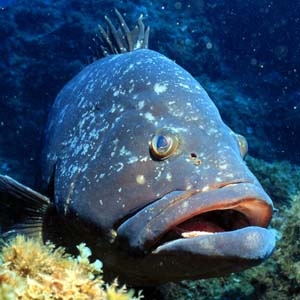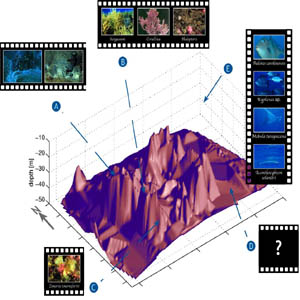Mapping
of Marine Biodiversity at Marine Special Areas of Conservation (SACs) in
the Azores
Frederico Cardigos & Fernando Tempera
Departamento de Oceanografia e Pescas da Universidade dos Açores,
Horta
Introduction
 |
Figure 1. Dusky grouper in Corvo Island voluntary marine protected area (J Fontes -
ImagDOP)
The Azores archipelago consists of nine islands scattered along 600km
of the northern part of the Mid Atlantic Ridge. The Department of
Oceanography and Fisheries of the University of the Azores (DOP/UAç)
has been working since 1976 in order to understand the processes that
control the marine ecosystems around the islands. European efforts
aiming at nature conservation recently provided resources to develop new
projects related to the management of sites included in the Natura 2000
network (e.g. EU - LIFE- Nature B4-3200/98/509: MARÉ - www.horta.uac.pt/projectos/life/).
There are seventeen marine areas classified as Sites of Community
Importance in the Azores. IMAR-DOP/UAç put forward projects to develop
management schemes for six of them. Background for this work was
research undertake on the sites in previous years (see Santos et al.,
1995 for review). Each of the selected sites has special features that
have contributed for its primary choice: isolation and wilderness
(Formigas bank), particular social context (Corvo island), unique
environment (D. João de Castro bank) and proximity to research
facilities (Monte da Guia, Baixa do Sul and Madalena islets). Along with
a series of other Azorean sites, the ones mentioned above are now
designated as BIOMARE Sites.
Work in the Faial-Pico channel
The channel between the islands of Faial and Pico contains a series
of designated areas (Monte da Guia, Baixa do Sul and Madalena islets)
and is located very close to IMAR-DOP/UAç. These areas are used as
primary sites where the scientific techniques are put together, tested
and, eventually, implemented. Until now, the work developed included
mainly the visual estimation of abundance and diversity of benthic and
fish assemblages by SCUBA diving, intertidal surveys and hand-seine
netting in sheltered bays.
These efforts have resulted in the definition of biotopes and mapping
of their distribution. Parallel work allowed the definition of basic
models for algal species abundance as a function of physical parameters
such as depth, wave exposure and bottom slope. These models are now
being entered as basic variables in the Geographic Information System of
specific sites around Faial and the consistency of the prediction
provided by these models and the observed distributions will be subject
to further discussion and refinement (Tempera et al., 2001c).
Together with an analysis of the socio-economical context of the
SACs, this research formed the basis for preliminary management plans
that will now be subject to public hearing (Tempera et al.,
2001d).
Future work includes the use of underwater technologies such as
Autonomous Underwater Vehicles (AUV), Autonomous Surface Vehicles (ASV),
Remote Operated Vehicle (ROV) (Pascoal et al., 2000) and eco-sounding
systems (such as CHIRP and BOOMER) (for details please see Project MAROV
web page http://www.horta.uac.pt/projectos/marov)
to explore habitats not easily accessible to SCUBA divers.
Management results in Corvo Island
 |
Figure 2 - Algae and Pseudolepidaplois
scrofa at Dollabarat reef (F Cardigos - ImagDOP)
Corvo Island, the smallest island of the archipelago with only 17 km2
and a population barely exceeding 400 inhabitants, has provided the
setting for a case where the protection of the environment was an
unexpected side effect of successive scientific missions closely
scrutinized by the local community. The scientific work developed in
Corvo Island extended for several years and allowed the scientific team
to understand and describe the habitats around the island. At the same
time, informal talks, articles published in popular magazines and TV
news reports on the local environment made the common citizen more aware
of the need to protect the environment. The bound established is
expected to result in a higher commitment and more successful
implementation of the set of management measures developed in close
cooperation with the local population.
These efforts have inclusively resulted in transformations of the
economic activities. A group of young entrepreneurs have changed their
exploitative perspective on marine living resources into a more
environmental-friendly one. They renounced spearfishing and started a
SCUBA-diving company. Together with the fishermen community and
scientists, the new tourism company established voluntary rules to
protect an area known to hold big dusky groupers (Epinephelus
marginatus), a feature that is already uncommon on the other islands
and very attractive to scuba divers (Figure 1) (Tempera et al.,
2002a and b).
Action on Formigas Bank
The Formigas offshore bank (which comprehends both the shallow rocky
bottoms around the Formigas islets and the Dollabarat reef) is located
between the islands of São Miguel and Santa Maria.
The scientific missions in this area allowed scientists to recognize
it as a pristine area with a high value for conservation (Figure 2). New
laws are being created in order to protect this area as Marine Reserve.
The novelty of this new status is of great interest to the Azorean
politicians who see this as a chance of promoting conservation values in
the marine environment, which is after all the main feature of the
Azores. The over-exploitation of neighbouring banks and coasts subject
to strong fisheries reinforces the importance of the protection of this
complex which might serve as the last source of recruits (Tempera et
al., 2001a and 2001b).
D. João de Castro Bank - a sleeping volcano
 |
Figure 3 - Species assemblages at D. João de
Castro Bank (L Sebastião - ISR and Grupo E)
In 1720 an underwater eruption gave birth to an ephemeral island,
right between São Miguel and Terceira islands. After three years, the
island disappeared, but a shallow water area with hydrothermal activity
remained until today. In order to understand the consequences of this
natural process for the ecosystem around it, detailed ecological
cartography of the area has been developed. Besides bacterial mats not
yet thoroughly identified, no new species were found, but more than 150
species have already been identified in this area. Mapping of the most
interesting species allowed us to draw three main conclusions: 1.
despite the presence of chemo-synthetic bacterial mats on the bank,
there are no food chains based on these bacteria; 2. there are some
influences of the vents in the species distribution in the shallow water
area (Ávila et al., submitted); 3. despite the absence of new records
of species for the Azores at the bank, there are some distinct species
assemblages (Figure 3).
The current trend for exploring this area is to go deeper in search
of other hydrothermal vent areas, which would represent the intermediate
between shallow water and the well-known deep-sea vents.
Future Trends
Biodiversity mapping is a basic tool for managing and protecting the
marine environment properly. The use of Geographic Information Systems
is one of the current trends in ecology studies (Wright, 1999). Using
this tool, it will be possible to easily visualize information, modify
it instantly, superimpose and model some basic interference. The need to
use GIS in the Azores has been increasing as a consequence of works such
as those mentioned above which gather large sets of geo-referenced data.
Another future trend is the development and introduction of tools to
explore deeper areas and, as a result, a better understanding of the
ecosystem as a whole.
Bibliography
Ávila, S.P., F. Cardigos and R.S. Santos
(submitted). Marine molluscs from "Banco D. João de Castro",
a shallow water hydrothermal-vent in the Azores: studying vent influence
in the ecosystem.
Pascoal, A., P. Oliveira, C. Silvestre, L.
Sebastião, M. Rufino, V. Barroso, J. Gomes, G. Ayela, P. Coince, M.
Cardew, A. Ryan, H. Braithwaite, N. Cardew, J. Trepte, N. Seube, J.
Champeau, P. Dhaussy, V. Sauce, R. Moitié, R. Santos, F. Cardigos, M.
Brussieux, P. Dando 2000. Robotic Ocean Vehicles for Marine Science
Applications: the European ASIMOV Project. Presented at OCEANS'2000.
Santos, R.S., S.J. Hawkins, L.R. Monteiro, M. Alves
& E.J. Isidro. 1995. Marine Research, Resources and Conservation in
the Azores. Aquatic Conservation: Freshwater and Marine Ecosystems, Vol.
5, No. 4:311-354.
Tempera, F., P. Afonso, T. Gomes & R. Santos.
2001a. Comunidades Biológicas do Sítio de Interesse Comunitário
Ilhéus das Formigas e Recife Dollabarat. Departamento de Oceanografia e
Pescas da Universidade dos Açores, Horta. Arquivos do DOP. Série
Relatórios Internos, nº 3/2001, iii+43 pp.
Tempera, F., P. Afonso, T. Gomes & R. Santos.
2001b. Proposta Técnico-Científica para Ordenamento do Sítio de
Interesse Comunitário Ilhéus das Formigas e Recife Dollabarat.
Departamento de Oceanografia e Pescas da Universidade dos Açores,
Horta. Arquivos do DOP. Série Relatórios Internos, nº 4/2001, v+17
pp.
Tempera, F., P. Afonso, T. Morato, R. Prieto, M.
Silva, A. Cruz, J. Gonçalves & R. Serrão Santos. 2001c.
Comunidades Biológicas dos Sítios de Interesse Comunitário do Canal
Faial-Pico. Departamento de Oceanografia e Pescas da Universidade dos
Açores, Horta. Arquivos DOP. Série Relatórios Internos, nº5/2001,
viii+76p
Tempera, F., P. Afonso, T. Morato, S. Gubbay, T.
Dentinho, M. Silva, R. Prieto, F. Cardigos, M.J. Pitta & R. Serrão
Santos. 2001d. Proposta Técnico-Científica de Ordenamento dos Sítios
de Interesse Comunitário do Canal Faial-Pico. Departamento de
Oceanografia e Pescas da Universidade dos Açores, Horta. Arquivos do
DOP. Série Relatórios Internos, nº8/2001, viii+76p.
Tempera, F., P. Afonso, T. Morato & R. Serrão
Santos. 2002 a. Comunidades Biológicas da Envolvente Marinha do Corvo.
Departamento de Oceanografia e Pescas da Universidade dos Açores,
Horta. Arquivos do DOP. Série Relatórios Internos, nº 1/2002, iv+52
pp.
Tempera, F., F. Cardigos, P. Afonso, T. Morato, M.
J. Pitta, S. Gubbay & R. Serrão Santos. 2002 b. Proposta
Técnico-Científica de Gestão da Envolvente Marinha do Corvo.
Departamento de Oceanografia e Pescas da Universidade dos Açores,
Horta. Arquivos do DOP. Série Relatórios Internos, nº 2/2001, vi+57
pp.
Wright, D.J. 1999. Down to the sea in ships: the
emergency of marine GIS. Marine and Coastal Geographic Information
Systems, Pp 1-10.
|
